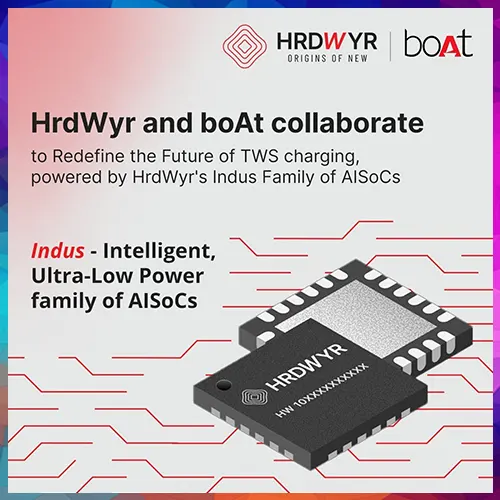
The announcement marks a strategic leap for boAt as it becomes the first Indian audio wearables brand to collaborate at the core semiconductor stage with a homegrown startup, debuting the Indus 1011 chip in premium TWS cases next year
India’s semiconductor ecosystem achieved a significant breakthrough with the launch of the HrdWyr Indus 1011, a fully indigenously designed, high-volume branded chip. Developed by semiconductor startup HrdWyr in collaboration with boAt, India’s No.1 audio wearables brand, and supported by Tata Electronics for assembly, packaging, and testing, the launch reflects India’s growing strength in driving innovation across the semiconductor value chain.
boAt pioneers indigenous chip support
The announcement marks a strategic leap for boAt, which has transitioned from working with international chipset providers to backing a domestic startup at the core semiconductor stage. This makes boAt the first Indian audio wearables brand to collaborate at such depth with a homegrown partner, underlining its commitment to India’s deep-tech ecosystem.
The Indus 1011 chip introduces significant advancements in intelligent battery management and will debut in boAt’s upcoming premium TWS charging cases early next year. By embracing indigenous innovation, boAt demonstrates both product differentiation and strategic foresight in nurturing India’s semiconductor capabilities.
“boAt has consistently backed the Make in India vision. We have always believed in pushing the boundaries of innovation to deliver world-class products. By taking the first-mover step to collaborate with HrdWyr at the semiconductor level, we are demonstrating that India’s consumer brands can be ecosystem enablers. We are proud to show that true product differentiation comes from innovation at the chip level, and this can be achieved right here in India,” said Sameer Mehta, Co-founder and CEO, boAt.
A collaborative model for innovation
The partnership represents a first-of-its-kind model for the Indian semiconductor sector. boAt brought consumer insights and market needs, while HrdWyr translated these into chip-level innovations by developing new IPs tailored for low-power, performance, and reliability using data-first principles to create next-generation AISoCs (AI System-on-Chips).
Tata Electronics completed the semiconductor ecosystem loop by enabling domestic assembly, packaging, and testing. With design, IP creation, and manufacturing executed in India, the collaboration reinforces the Government’s vision of Atmanirbhar Bharat, Make in India, and the India Semiconductor Mission.
“Semiconductors and AI are the foundation of all modern economies. Strategic autonomy in semiconductor innovation and supply chain is an imperative for large economies like India. Fabless product companies like HrdWyr are critical to achieving this goal, eventually taking Indian innovation to the world. This milestone proves that India can innovate at the deepest levels of technology – semiconductor product design and IP creation. With boAt’s bold trust in a homegrown chip and Tata Electronics’ manufacturing capabilities, we are showing that India’s semiconductor ecosystem is ready for global scale,” said Ramamurthy Sivakumar, Co-founder and CEO, HrdWyr.
Defining proof point for India’s vision
More than a product milestone, the Indus 1011 symbolizes a proof point for India’s semiconductor ambitions. By betting on a homegrown chip, boAt has created a new model of consumer brand–startup collaboration, while HrdWyr has showcased India’s ability to deliver deep-tech innovation at global standards.
The collaboration positions India as not just a consumer but also a creator of semiconductor IP, reinforcing long-term national goals for Viksit Bharat 2047 and strengthening India’s presence on the global technology stage.
See What’s Next in Tech With the Fast Forward Newsletter
Tweets From @varindiamag
Nothing to see here - yet
When they Tweet, their Tweets will show up here.




























